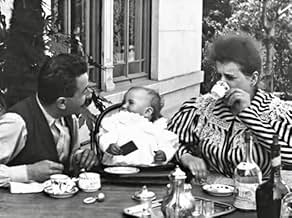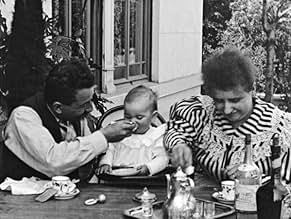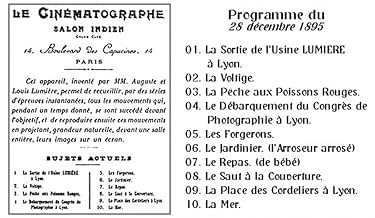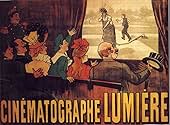VALUTAZIONE IMDb
5,9/10
3701
LA TUA VALUTAZIONE
Aggiungi una trama nella tua linguaAs part of a maiden public film screening at the Salon Indien, on December 28, in Paris, Auguste Lumière pivots the centre of attention around his baby daughter, as he tries to feed her from... Leggi tuttoAs part of a maiden public film screening at the Salon Indien, on December 28, in Paris, Auguste Lumière pivots the centre of attention around his baby daughter, as he tries to feed her from a spoon.As part of a maiden public film screening at the Salon Indien, on December 28, in Paris, Auguste Lumière pivots the centre of attention around his baby daughter, as he tries to feed her from a spoon.
Recensioni in evidenza
Two loving parents feed their happy baby on the perch of their country home. It is often said that these early Lumiere shorts are primitive because they have not yet mastered basic film grammar, such as camera movement, editing or the close-up, films like these being a simple, static set-u;, the camera pointing at the scene from a middle distance. But as filmmakers like Godard, Ozu and Kitano, for instance, realised, that very grammar can be a violation of the integrity of the image, forcing us to concentrate of the structure in which the image is only a unit, rather than the image itself.
There is nothing primitive or simple about this particular image; as critics have noted, this film offers two levels of movement, one human, recognisable, communal (the family); the other (the trees blowing) part of a different order altogether, of nature, cycles, immemoriality. So while the family represents a similar idea of continuity as the trees, of the species being reproduced, it sis also offered in stark contraast to them, as each member of the trio will eventually die, for all the nourishment and fertility, while nature lives on, indifferent.
This frisson of mortality undercuts the film's essential conservatism, and differentiates it from the sinister surveillance of the earlier 'Sortie d'Usine'. This recognition that the powers of the camera-wielding Lumieres are in fact limited, that they are not as omniscient as they once thought they were, is perhaps dramatised in the figure of the father, one of the brothers, one of the first great director-stars, paving the way for Chaplin, Keaton and Welles. His crossing the line from director to star, from passive to active, from subject to object, represents a breach between the observer and observed, a breaking of that invisible line, a destruction of that contract Hollywood will try so desperately to enforce, between reality and fiction. The watcher is now the watched, distinctions and hierarchies have been abolished.
Ironically, immortality has been conversely guarenteed - while the man behind the camera is lost, fading into a mere eye, a role taken over by every viewer, the actor brother is trapped forever in this rigid, simple domestic scenario, feeding the ever-hungry, unthinking baby, a harbinger of the medium he invented.
There is nothing primitive or simple about this particular image; as critics have noted, this film offers two levels of movement, one human, recognisable, communal (the family); the other (the trees blowing) part of a different order altogether, of nature, cycles, immemoriality. So while the family represents a similar idea of continuity as the trees, of the species being reproduced, it sis also offered in stark contraast to them, as each member of the trio will eventually die, for all the nourishment and fertility, while nature lives on, indifferent.
This frisson of mortality undercuts the film's essential conservatism, and differentiates it from the sinister surveillance of the earlier 'Sortie d'Usine'. This recognition that the powers of the camera-wielding Lumieres are in fact limited, that they are not as omniscient as they once thought they were, is perhaps dramatised in the figure of the father, one of the brothers, one of the first great director-stars, paving the way for Chaplin, Keaton and Welles. His crossing the line from director to star, from passive to active, from subject to object, represents a breach between the observer and observed, a breaking of that invisible line, a destruction of that contract Hollywood will try so desperately to enforce, between reality and fiction. The watcher is now the watched, distinctions and hierarchies have been abolished.
Ironically, immortality has been conversely guarenteed - while the man behind the camera is lost, fading into a mere eye, a role taken over by every viewer, the actor brother is trapped forever in this rigid, simple domestic scenario, feeding the ever-hungry, unthinking baby, a harbinger of the medium he invented.
A father with his wife at the table feeds his son , who then offers a cookie to his parents while the wind moves the trees. There is a time when children will have to feed their aged parents and already before time this child offers them food!
Repas de Bebe was one of the films on the bill of the Lumiere brothers' first exhibition of motion pictures for a paying audience. The basement room of the Hotel Salon Indien the brothers hired for the occasion was half-empty on the first ever cinema screening - but the second night was a sell-out. Of course, by today's standards most of the film's appear quite crude and this one is no great shakes but it does capture a tender family moment as Auguste Lumiere and his wife feed their baby son. It's a shot that's been repeated millions of times since by anyone who ever had a family and owned a cine camera/video camera or mobile phone, and as such there's a certain poignancy to it.
Louis Lumiere's brother, Auguste, and his wife sit at a table, in their garden, feeding their child - who sits between them. Shrubbery in the background rustles indicating a slight breeze. Perhaps the public, in 1896, would see this and wish they could preserve family scenes such as this for their posterity. Now, 107 years later, we can - on film or video. We have come a long way, baby!
On a cold day of December in 1895, two photo technicians named Auguste and Louis Lumière rented the Salon Indien Du Grand Café to show the results of a series of experiments they had been making since 1892. As workers of their father's photographic firm, their work in the development of better process to make photographs wasn't unknown, but what the brothers showed to their limited audience that day was far beyond what anyone could have imagined. On that day, cinema was born, as the brothers' invention, the Cinématographe, allowed to project moving images on a screen, a considerable improvement over the popular Kinetoscope (which showed the images through a peephole). As photographers themselves, the brothers considered their invention to be the natural evolution of photography, so most of the movies they showed that day were done to show the idea that like photography, cinema was here to capture memories, albeit in a more vivid way.
Of the 10 short films the brothers screened on that historical day, most were of course devised to show the movement of the images (people walking, exercising, or simply the traffic passing on the street), but the others had specific purposes to show the brothers' ideas of what kind of uses give to the new invention. One was of course the shooting of the arrival of the Congress of Photographers in Lyon, aimed to show cinema as a new way to document history; there was also "L'Arroseur Arrosé", which showed cinema as a way to tell a simple and fun little story; and finally, there were the movies that, like photographs, captured family moments. "Repas De Bébé" (literally, "Baby's Meal") was one of that kind of movie, as the film showed Auguste Lumière and his wife Marguerite, while they are having breakfast with their baby daughter Andrée.
While one could even say that the movie doesn't have anything special besides the fact that it was among the first movies screened in history; "Repas De Bébé" is probably the movie that represents the Lumières' ideal of cinema the most, as like a photography, the movie captures a charming moment in the life of a family that can be revisited anytime, with the advantage of having it moving. This meant that we could not only remember how persons looked in the past, we were now able to see how they behaved, what they did or simply how they really lived. It was more than a documentary or an actuality film, this was essentially a memory being caught on film and saved for posterity. One can make the argument that film videos were born with this movie, and for that reason alone, "Repas De Bébé" has a special place in the history of film. 6/10
Of the 10 short films the brothers screened on that historical day, most were of course devised to show the movement of the images (people walking, exercising, or simply the traffic passing on the street), but the others had specific purposes to show the brothers' ideas of what kind of uses give to the new invention. One was of course the shooting of the arrival of the Congress of Photographers in Lyon, aimed to show cinema as a new way to document history; there was also "L'Arroseur Arrosé", which showed cinema as a way to tell a simple and fun little story; and finally, there were the movies that, like photographs, captured family moments. "Repas De Bébé" (literally, "Baby's Meal") was one of that kind of movie, as the film showed Auguste Lumière and his wife Marguerite, while they are having breakfast with their baby daughter Andrée.
While one could even say that the movie doesn't have anything special besides the fact that it was among the first movies screened in history; "Repas De Bébé" is probably the movie that represents the Lumières' ideal of cinema the most, as like a photography, the movie captures a charming moment in the life of a family that can be revisited anytime, with the advantage of having it moving. This meant that we could not only remember how persons looked in the past, we were now able to see how they behaved, what they did or simply how they really lived. It was more than a documentary or an actuality film, this was essentially a memory being caught on film and saved for posterity. One can make the argument that film videos were born with this movie, and for that reason alone, "Repas De Bébé" has a special place in the history of film. 6/10
Lo sapevi?
- QuizFilm historians often jokingly refer to this film as the first 'home movie,' as it depicts the filmmaker's home life in a documentary fashion, without any attempt at narrative contrivances.
- ConnessioniEdited into The Lumière Brothers' First Films (1996)
I più visti
Accedi per valutare e creare un elenco di titoli salvati per ottenere consigli personalizzati
Dettagli
- Tempo di esecuzione
- 1min
- Colore
- Mix di suoni
- Proporzioni
- 1.33 : 1
Contribuisci a questa pagina
Suggerisci una modifica o aggiungi i contenuti mancanti



















